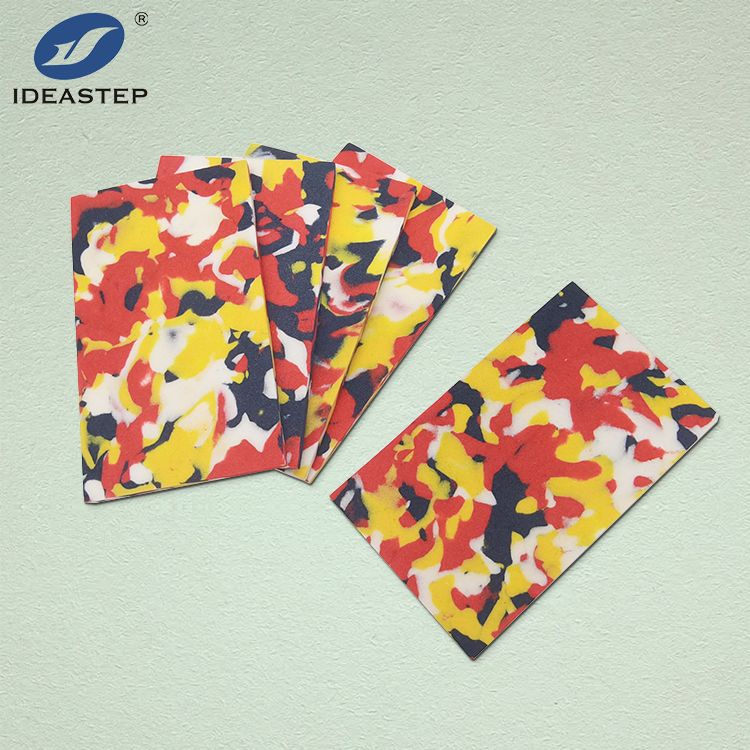EVA (Ethylene Vinyl Acetate) material is highly versatile and can be customized to meet specific needs across various applications. This flexibility allows businesses to benefit from tailored solutions that enhance performance, comfort, and overall effectiveness.
EVA (Ethylene Vinyl Acetate) material has become a popular choice for numerous applications due to its flexibility, durability, and performance characteristics. One of the key advantages of EVA is its ability to be customized to suit specific needs, making it an ideal material for various industries. This article explores the customization options available for EVA material and the associated benefits, helping businesses and consumers make informed decisions about their material choices.

1. Customization Options for EVA Material
Customizing EVA material involves adjusting its properties to meet specific requirements. The primary customization options include:
- Thickness and Density: EVA material can be manufactured in various thicknesses and densities to suit different applications. For instance, thicker EVA is often used for cushioning and shock absorption, while thinner EVA may be chosen for lightweight applications. Adjusting density can impact the material’s firmness and flexibility, allowing for tailored performance characteristics.
- Color and Aesthetics: EVA can be produced in a wide range of colors and finishes, making it suitable for products that require visual appeal. Custom colors and textures can be achieved through dyeing or adding color pigments during the manufacturing process, enhancing the aesthetic value of the final product.
- Formulation and Additives: Different formulations of EVA can be customized by incorporating additives to enhance specific properties such as UV resistance, flame retardancy, or antimicrobial qualities. Additives can improve the material’s performance in various environments, making it suitable for specialized applications.
- Surface Texture: The surface texture of EVA material can be customized to provide different levels of grip, smoothness, or cushioning. Textured surfaces can enhance traction and comfort, while smooth surfaces may be preferred for aesthetic reasons or specific functional requirements.

2. Benefits of Customizing EVA Material
Customizing EVA material offers several benefits, including:
- Enhanced Performance: By tailoring the thickness, density, and formulation of EVA material, businesses can achieve specific performance characteristics that align with their product requirements. For example, customized cushioning can improve comfort in footwear, while specialized additives can enhance durability and resistance to environmental factors.
- Improved Aesthetics: Custom colors and textures allow products to stand out in the market, providing a competitive edge. Attractive and unique designs can appeal to consumers and enhance brand identity. Customization options also enable products to align with corporate branding and design specifications.
- Increased Functionality: Custom EVA materials can be designed to meet specific functional needs, such as improved shock absorption, thermal insulation, or chemical resistance. Tailored materials can enhance the overall functionality of products, making them more effective and reliable in their intended applications.
- Cost Efficiency: While customization may involve higher initial costs, it can lead to long-term cost savings by improving product performance and longevity. Custom EVA materials can reduce the need for additional components or modifications, resulting in more efficient production processes and lower overall costs.

3. Applications of Customized EVA Material
Customized EVA material is used in various industries and applications, including:
- Footwear: In the footwear industry, customized EVA is used for insoles, midsoles, and outsoles. Tailored cushioning and support enhance comfort and performance, catering to specific needs such as arch support, shock absorption, and durability.
- Sports Equipment: EVA material is widely used in sports equipment, including padding, protective gear, and accessories. Customized EVA provides improved impact resistance, cushioning, and flexibility, enhancing the safety and performance of sports products.
- Packaging: EVA is also used in packaging solutions due to its cushioning properties. Custom EVA can be designed to fit specific product shapes and sizes, providing effective protection during shipping and handling.
- Medical Devices: In the medical field, customized EVA material is used in orthotic insoles, prosthetics, and other devices. Tailored properties can improve comfort, support, and overall effectiveness in medical applications.
4. Choosing the Right Customization Option
When selecting customization options for EVA material, consider the following factors:
- Application Requirements: Evaluate the specific needs of your application, such as performance characteristics, environmental conditions, and aesthetic preferences. Choose customization options that align with these requirements to ensure optimal performance and functionality.
- Budget Constraints: While customization can offer significant benefits, it is essential to balance these benefits with budget constraints. Assess the cost implications of different customization options and choose those that provide the best value for your investment.
- Supplier Expertise: Work with experienced suppliers who have expertise in customizing EVA material. Their knowledge and capabilities can ensure high-quality results and help achieve the desired specifications.
Conclusion
Customizing EVA material provides numerous advantages, including enhanced performance, improved aesthetics, increased functionality, and potential cost savings. By understanding the available customization options and benefits, businesses and consumers can make informed decisions and optimize their use of EVA material for various applications. Whether for footwear, sports equipment, packaging, or medical devices, tailored EVA solutions offer significant value and effectiveness in meeting specific needs.
FAQ
1. What are the main customization options for EVA material?
Main customization options for EVA material include thickness and density, color and aesthetics, formulation and additives, and surface texture. Each option can be adjusted to meet specific performance and functional requirements.
2. How does customizing EVA material benefit businesses?
Customizing EVA material benefits businesses by enhancing product performance, improving aesthetics, increasing functionality, and potentially reducing long-term costs. Tailored materials can provide competitive advantages and better meet specific application needs.
3. What factors should be considered when choosing customization options for EVA material?
Factors to consider include application requirements, budget constraints, and supplier expertise. Evaluating these factors helps in selecting the most suitable customization options to achieve desired performance and cost-effectiveness.
